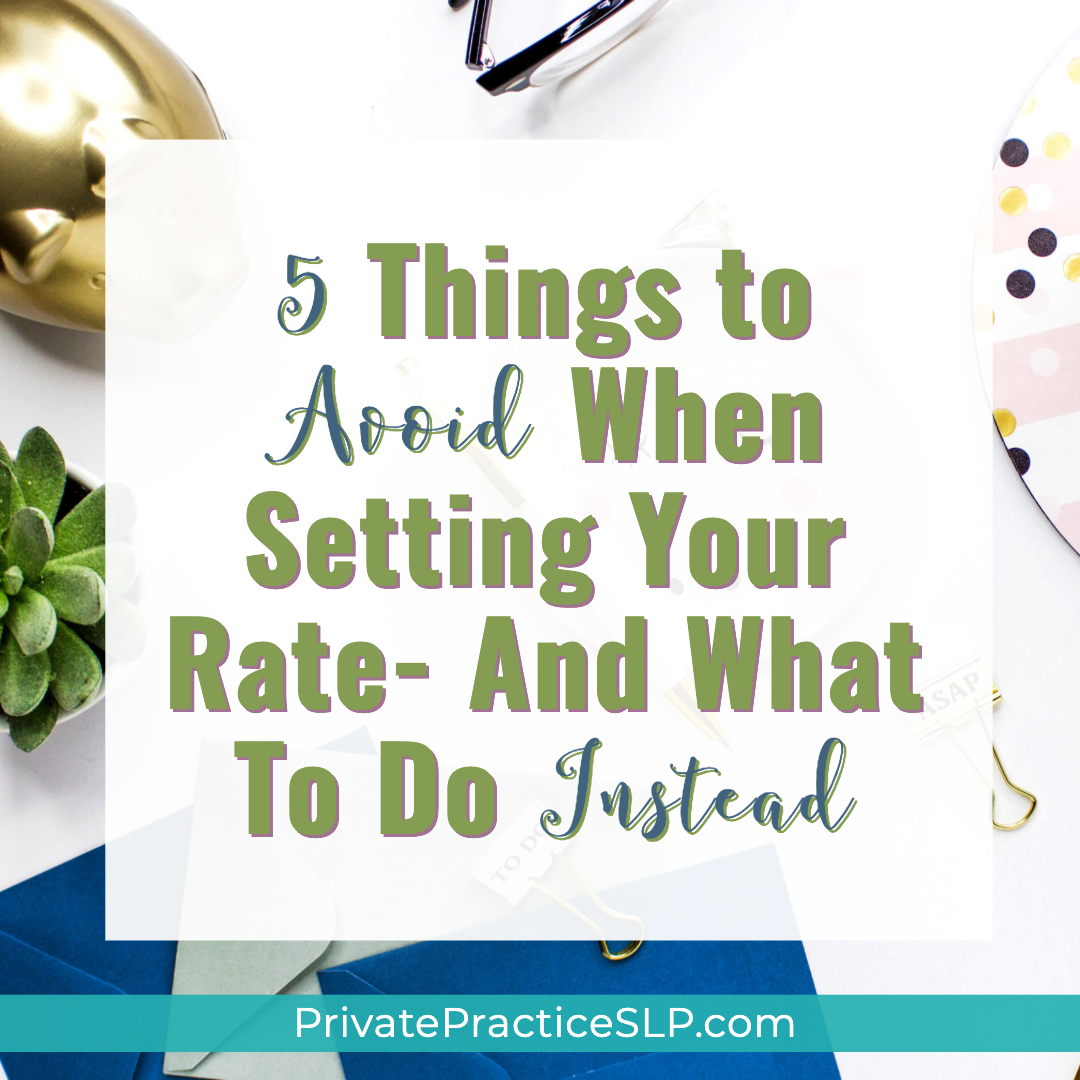How To Set Your Session Rate for SLPs
The number one question that I am asked, that I see asked about starting a private practice, and that I myself asked when I was starting my practice is, "How do I set my rate?"
It's important to figure out, since it is the basis for setting your budget and finding out if this private practice thing is actually going to work for you financially. But there's not a lot of solid, evidence-based information out there about what to do- and what not to do- when setting that rate.
ASHA has some information on it, but it is intentionally vague because they can't legally be too specific. They advise checking the CMS (Centers for Medicare and Medicaid) fee schedule and perhaps even purchasing historic fee data from Milliman. In addition to those options, here are my 5 things to avoid when setting your rate- and what to do instead.
5 Ways NOT to Set Your SLP Rate
1. ONLY using the CMS fee schedule.
The CMS fee schedule, while helpful because you can look up fee information for your MAC (Medicare Administrative Contractor- the local administrative area covered by your CMS branch) by CPT code, isn't the be-all-and-end-all since their rates tend to be on the low end. It also just tells you what the Medicare rate is, which is set at the federal level, because Medicaid rates are set by states.
What to do instead: To get a better picture of the actual rates in your area, use the CMS schedule with the Fair Health Consumer guide, which allows you to search by both In-Network and Out-of-Network rates. The CMS rate is intended for providers, while the Fair Health Consumer rates are intended for patients to see what they might expect to pay for a given procedure (CPT code). Use the non-hospital rate as a guide, NOT the hospital rate. Note: the Fair Health Consumer rates are NOT to be used as specific data to base your rates on- they are ONLY a way to find out what the average cost is for patients in your area.
2. Just asking other practices in your area what they charge
While knowing what others charge is helpful, ASHA strongly advises against just asking around about what other local clinics are charging. As they say, "Discussing fees with other local providers may be construed as price fixing. Setting prices in collusion with colleagues is illegal."
What to do instead: No one is probably going to arrest you for asking a colleague what they charge, but it is best to use the other advice in this list rather than just crowdsourcing such an important part of your practice. Remember- YOUR rate is based on YOUR experience, budgetary bottom line, specialties, and overhead. One size does NOT fit all.
3. Not taking your experience and specializations into account
The fee schedules listed above are across-the-board basics- they don't take factors like your experience or extra trainings into account. Are you trained in PROMPT or FEES? Do you have 15 years of experience with a specific population? Do you specialize in a specific disorder? Don’t undervalue yourself!
What to do instead: Take all of that into account when setting your rate. Write down every training you’ve taken and certification you have- you’ll probably be surprised at how much you know!
4. Having a sliding fee scale without specific requirements
Having a sliding fee scale for needy families is an admirable and legal thing to do- IF you do it correctly.
What to do instead: You MUST set requirements for the reduced rates, and each family must qualify for the reduced rate based on those requirements. You can't just have the Jones' paying X and the Smiths paying Y because you feel worse for the Smiths.
You can use any criteria you like, although income based (requiring proof of income) is the most common, but you MUST use the same requirements for all applicants.
5. Having a "set it and forget it" mindset
You will set your rate when you start your practice, but it's not a Ronco rotisserie chicken- you don't just set it and forget it! You can increase your rates for all clients or just new clients, but don’t keep the same rates forever. Insurance companies will only reimburse what their contract states, and that doesn’t often change, but the rate you charge them should go up, as should your private pay rate.
What to do instead: If you are in business for any length of time, you will need to adjust your rates for cost of living, experience, and other factors. If you worked for an employer, you would expect a raise after you worked there for a bit- don't shortchange yourself (literally) when you work for yourself.
Use these tips each time you think about changing your rate, to help you do it legally and effectively. And remember- you have to accept payment in a HIPAA compliant manner (not via Paypal, Venmo, or Zelle). Here’s a blog post I wrote on billing.
Want more information about setting your rate? I teamed up with Hannah Boeck from Cued Creative to create our Setting Your Rates Workbook to help!
If you want more information about starting a practice, including in-depth information about setting your rate, it's available in my Private Practice Foundations course from Northern Speech Services- a one-stop guide to starting your private practice.
Need someone to talk you through the process of setting your rate? Try a video consult with me! I can help you set the best rate for your specific practice!







